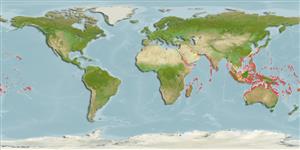Common names from other countries
>
Gobiiformes (Gobies) >
Gobiidae (Gobies) > Gobiinae
Etymology: Fusigobius: Latin, fusus = spindle + Latin, gobius = gudgeon (Ref. 45335).
More on author: Günther.
Environment: milieu / climate zone / depth range / distribution range
Ecologia
marinhas associadas(os) a recifes; intervalo de profundidade 0 - 25 m (Ref. 11441). Tropical; 21°C - 30°C (Ref. 27115); 35°N - 33°S, 32°E - 143°W
Indo-Pacific: East Africa to the Tuamoto Islands, north to Ryukyu Islands, south to Lord Howe Island.
Tamanho / Peso / Idade
Maturity: Lm ? range ? - ? cm
Max length : 7.5 cm TL macho/indeterminado; (Ref. 2334)
Descrição breve
Chaves de identificação | Morfologia | Morfometria
Espinhos dorsais (total) : 7; Raios dorsais moles (total) : 9; Espinhos anais: 1; Raios anais moles: 8. 1st black spot between 1st 2 dorsal spines; body with small dark spots (Ref. 2798); characterized by semi-translucent grey with small brown spots on head and body; presence of slanting bands along back; fully united pelvic fins; well developed pelvic frenum; rounded caudal fin; longitudinal scale series 22-24; ctenoid scales those on nape; cycloid scales on breast and base of pectoral fin; operculum without scales; median predorsal scales absent, 5-6 scales on side of nape anterior to dorsal fin origin; opening of gill extending nearly to below rear edge of opercle; depth of body 4.0-4.6 in SL (Ref. 90102).
Solitary or in small groups (Ref. 90102). Inhabits tidal reef flats and shallow lagoons, on sand or rubble patches (Ref. 48637). Feeds on organic matter and small benthic invertebrates (Ref. 89972).
Life cycle and mating behavior
Maturities | Reprodução | Spawnings | Egg(s) | Fecundities | Larvas
Benthic spawner.
Randall, J.E., 1995. Coastal fishes of Oman. University of Hawaii Press, Honolulu, Hawaii. 439 p. (Ref. 11441)
Categoria na Lista Vermelha da IUCN (Ref. 130435)
CITES (Ref. 128078)
Not Evaluated
Ameaça para o homem
Harmless
Utilização humana
Pescarias: espécies comerciais; Aquário: Espécies comerciais
Ferramentas
Relatórios especiais
Descarregue XML
Fontes da internet
Estimates based on models
Preferred temperature (Ref.
115969): 24.7 - 29.3, mean 28.2 (based on 3017 cells).
Phylogenetic diversity index (Ref.
82804): PD
50 = 0.5005 [Uniqueness, from 0.5 = low to 2.0 = high].
Bayesian length-weight: a=0.01023 (0.00477 - 0.02194), b=3.02 (2.84 - 3.20), in cm Total Length, based on LWR estimates for this (Sub)family-body shape (Ref.
93245).
Nível Trófico (Ref.
69278): 2.9 ±0.25 se; based on food items.
Resiliência (Ref.
120179): Elevada, tempo mínimo de duplicação da população menor que 15 meses (Preliminary K or Fecundity.).
Fishing Vulnerability (Ref.
59153): Low vulnerability (10 of 100).
